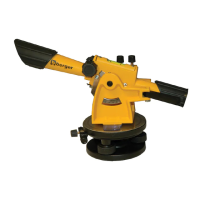IMPORTANT!
READ THIS BEFORE USING THE INSTRUMENT
This quality Berger instrument has been inspected twice for accuracy before leaving
the factory. The instrument has also been given the best protection possible against
damage during transportation. Even with these precautions, the instrument is
subject to rough handling during shipment. To protect yourself against the possibility
of using an instrument which is out of adjustment, we suggest that you have the
instrument checked by a competent person before using it.
The following test can be performed to check the instrument’s accuracy:
Set up the instrument in an area that is as level as possible and which is about 220
feet long. Place two matching level rods (or drive two pieces of strapping into the
ground) about 200 feet apart with the faces toward each other. Position and level the
instrument so that the distance from the instrument to each rod is the same
(measure) (Fig. 1A).
Take a reading on each rod with the instrument (or mark each piece of strapping
where the crosshair is sighted). Note the difference and record them. Next, move the
instrument to another point in line with the two level rods as shown (Fig. 2A). Level
the instrument and take readings on the two level rods (or remark the two pieces of
strapping with the new crosshair sightings). The differences should be the same ( A -
A' should equal B - B'). The difference between A - A' and B - B' is the instrument
error at 200 feet.
Correction of instrument error should be performed by a competent repair
technician. The instrument should be rechecked periodically to assure
continued accuracy.
Berger Instruments • 3
The purpose of this manual is to furnish a basic understanding of your instrument
and how it can be used to solve many common building and construction problems.
Your instrument is precision made and capable of numerous applications. Listed in
the table of contents are a few representative building, engineering and farming
problems.
CONTENTS
1. Setting up the Instrument on the Tripod 4
2. Leveling the Three Screw Instrument 4
3. Bubble Adjustments 5
4. Plate Bubble Adjustment 5
5. Preparing Telescope for Use 6
6. Leveling and Difference of Elevation 6
6.1 Leveling Rods 6
6.2 Inches and Decimal Portions of a Foot 6
6.3 To Measure a Difference in Elevation from One Set-up 7
6.4 To Measure a Difference in Elevation
Requiring More Than One Set-up 8
6.5 Elevations or Grades 8
7. Measuring and Laying Out Horizontal Angles 9
7.1 Setting Up Over a Point with Plumb Bob 9
7.2 Measuring Horizontal Angles 9
8. Reading the Vernier 10
8.1 The Horizontal Vernier 10
8.2 The Vertical Vernier 11
9. Special Uses of Transit-Level Instruments 12
9.1 Setting Points in Line 12
9.2 Plumbing 12
10. Slopes and Rates of Grades 13
11. Practical Applications 14
11.1 Grade Line for a Sewer 14
11.2 Batter Boards for a Sewer 14
12. Stadia Distance Measuring 15
13. Care of Instrument 16
14. Warranty 17
15. Adjustment Points 18
2
••
Berger Instruments
Fig. 1A
Fig. 2A

